The SandForce Roundup: Corsair, Kingston, Patriot, OCZ, OWC & MemoRight SSDs Compared
by Anand Lal Shimpi on August 11, 2011 12:01 AM ESTAnandTech Storage Bench 2011
Last year we introduced our AnandTech Storage Bench, a suite of benchmarks that took traces of real OS/application usage and played them back in a repeatable manner. I assembled the traces myself out of frustration with the majority of what we have today in terms of SSD benchmarks.
Although the AnandTech Storage Bench tests did a good job of characterizing SSD performance, they weren't stressful enough. All of the tests performed less than 10GB of reads/writes and typically involved only 4GB of writes specifically. That's not even enough exceed the spare area on most SSDs. Most canned SSD benchmarks don't even come close to writing a single gigabyte of data, but that doesn't mean that simply writing 4GB is acceptable.
Originally I kept the benchmarks short enough that they wouldn't be a burden to run (~30 minutes) but long enough that they were representative of what a power user might do with their system.
Not too long ago I tweeted that I had created what I referred to as the Mother of All SSD Benchmarks (MOASB). Rather than only writing 4GB of data to the drive, this benchmark writes 106.32GB. It's the load you'd put on a drive after nearly two weeks of constant usage. And it takes a *long* time to run.
1) The MOASB, officially called AnandTech Storage Bench 2011 - Heavy Workload, mainly focuses on the times when your I/O activity is the highest. There is a lot of downloading and application installing that happens during the course of this test. My thinking was that it's during application installs, file copies, downloading and multitasking with all of this that you can really notice performance differences between drives.
2) I tried to cover as many bases as possible with the software I incorporated into this test. There's a lot of photo editing in Photoshop, HTML editing in Dreamweaver, web browsing, game playing/level loading (Starcraft II & WoW are both a part of the test) as well as general use stuff (application installing, virus scanning). I included a large amount of email downloading, document creation and editing as well. To top it all off I even use Visual Studio 2008 to build Chromium during the test.
The test has 2,168,893 read operations and 1,783,447 write operations. The IO breakdown is as follows:
| AnandTech Storage Bench 2011 - Heavy Workload IO Breakdown | ||||
| IO Size | % of Total | |||
| 4KB | 28% | |||
| 16KB | 10% | |||
| 32KB | 10% | |||
| 64KB | 4% | |||
Only 42% of all operations are sequential, the rest range from pseudo to fully random (with most falling in the pseudo-random category). Average queue depth is 4.625 IOs, with 59% of operations taking place in an IO queue of 1.
Many of you have asked for a better way to really characterize performance. Simply looking at IOPS doesn't really say much. As a result I'm going to be presenting Storage Bench 2011 data in a slightly different way. We'll have performance represented as Average MB/s, with higher numbers being better. At the same time I'll be reporting how long the SSD was busy while running this test. These disk busy graphs will show you exactly how much time was shaved off by using a faster drive vs. a slower one during the course of this test. Finally, I will also break out performance into reads, writes and combined. The reason I do this is to help balance out the fact that this test is unusually write intensive, which can often hide the benefits of a drive with good read performance.
There's also a new light workload for 2011. This is a far more reasonable, typical every day use case benchmark. Lots of web browsing, photo editing (but with a greater focus on photo consumption), video playback as well as some application installs and gaming. This test isn't nearly as write intensive as the MOASB but it's still multiple times more write intensive than what we were running last year.
As always I don't believe that these two benchmarks alone are enough to characterize the performance of a drive, but hopefully along with the rest of our tests they will help provide a better idea.
The testbed for Storage Bench 2011 has changed as well. We're now using a Sandy Bridge platform with full 6Gbps support for these tests. All of the older tests are still run on our X58 platform.
AnandTech Storage Bench 2011 - Heavy Workload
We'll start out by looking at average data rate throughout our new heavy workload test:

Our Storage Bench suite groups performers according to die count/drive capacity. The 240GB drives are faster than the 120GB counterparts. There's also not much of a difference between the drives with synchronous vs. asynchronous NAND.
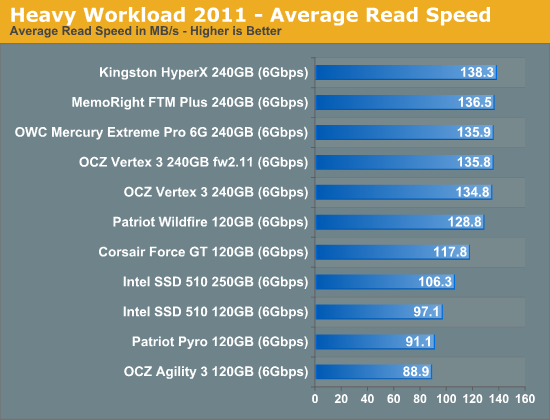
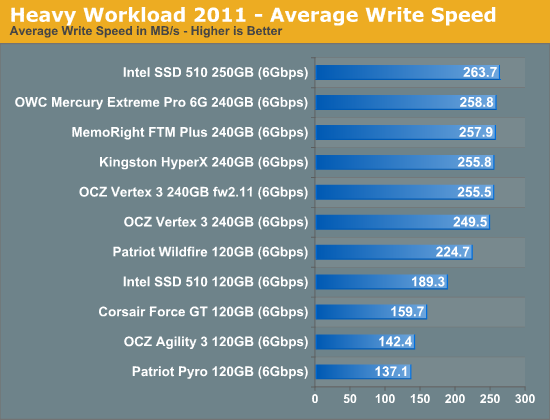
The next three charts just represent the same data, but in a different manner. Instead of looking at average data rate, we're looking at how long the disk was busy for during this entire test. Note that disk busy time excludes any and all idles, this is just how long the SSD was busy doing something:
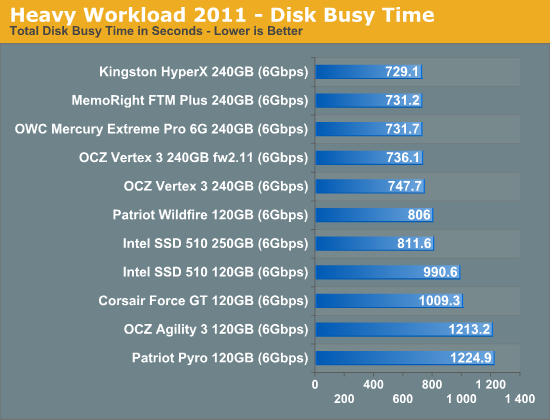
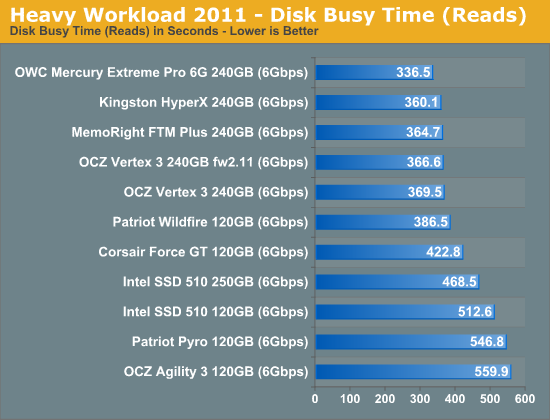
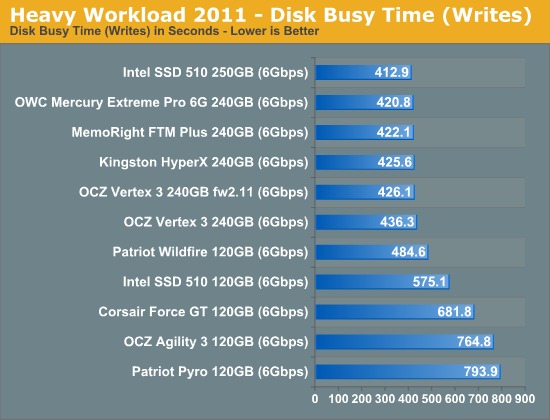










90 Comments
View All Comments
Ipatinga - Thursday, August 11, 2011 - link
So, the Corsair Force GT is really going against OCZ Vertex 3? I thought it was agains Vertex 3 Max IOPS.In this case, the Corsair Force 3 is going after Agility 3?
And Corsair Performance 3 is going after Solid 3?
Thanks :)
Would like to hear more about NAND Flash that is Async and Sync and Toogle.
bob102938 - Thursday, August 11, 2011 - link
There are some factors that were not considered on the first page of the article. The number of dies per wafer is important, but you are forgetting the cost of producing a flash memory wafer vs a VLSI wafer. Flash memory is a ~20 layer process that has margins for error which can be worked around. VLSI is a 60+ layer process that has 0 margin for error. Producing flash memory wafers is more than an order of magnitude cheaper than producing the same-size VLSI wafer. Additionally, turnaround time on a flash wafer can be achieved in ~20 days, whereas a VLSI wafer can require 3 months.Also the internal cost of a 300mm flash memory wafer is more like $1000. A VLSI wafer is around $8000.
philosofool - Thursday, August 11, 2011 - link
I don't want to blame the victims, end users. Obviously, manufacturers have a responsibility to QA.Still, when you look at the market forces here, it seems obvious that market forces are driving the problem.
Manufacturer makes the COOL drive that gets the best performances marks of any drive out there. One year later, the COOLER drive is released. No one wants a COOL drive anymore. Plus, the margin making COOL drives is so small, you can't drop your price on a COOL drive to make it an attractive "midrange" option. So you have to start developing a new controller to make something down-right freezing.
Because there's such an emphasis on performance, controllers and the drives they run become obsolete before a water-tight reliable version of the controller can be made. Of course, they're not really obsolete--there's nothing wrong with the X-25M controller--but they can't compete in a market with drives that show twice the random read performance of an unreliable competitor.
Constant R&D on new controllers and the demand for performance mean that reliability takes a backseat. You can't sell COOL drives as long as someone makes a COOLER drive, even if cooler drives have reliability problems. Think about yourself: would you buy an X-25 M knowing that you could get a Vertex 3 instead?
Bannon - Thursday, August 11, 2011 - link
I built a system on an Asus P8Z68 Deluxe motherboard and used two Intel 510 250GB drives with it. One is the system drive and the other data drive with firmwares PWG2 and PWG4 respectively. To date I have not experienced a BSOD BUT my system drive will drop from 6Gbs to 3Gbs for no apparent reason and stay there until I power the system off. My data drive is rock solid at 6Gbs and stays there. I've just started working with Intel so I don't know where that is going to lead. Hopefully it end up with a new drive with the latest firmware and 6Gbs performance. Given my druthers I'd rather have this problem than the Sandforce BSOD's but I wanted to point out that everything isn't perfect in Intel-land.Coup27 - Thursday, August 11, 2011 - link
Anand,Can we ever expect a 470 review?
nish0323 - Thursday, August 11, 2011 - link
or am I the only one about the fact that the OWC drive is the ONLY one with a 5 year warranty on it!! That's nuts... they actually back up the claim of their SSD drive longevity by giving you such a long warranty. I love SSDs.OWC Grant - Friday, August 12, 2011 - link
Glad you noticed that warranty term because it's somewhat related to topic of this article. I've been in direct contact with Anand on this as the tone of article is all-encompassing and I wanted to shed some light on that from our perspective.While many SF based SSDs share firmware, not all hardware is the same. Our SSDs have subtle design and/or component differences which is what we feel reduces or eliminates our products susceptibility to the BSOD issue.
The honest truth is we have not been able to create a BSOD issue here with our SSDs using the same procedures that caused other brands' SSDs to experience BSOD. Nor have we received or read one direct report of such an occurrence using our drives.
And while we cut our teeth so to speak in the Mac industry, PLENTY of PC users have our SSDs in their systems...as well as that we do extensive testing on a variety of motherboards/system configs to ensure long term reliable operation.
More supportive perhaps is the fact that we've had other brand users who experienced BSOD, but after buying our SSD, they reported back that it eliminated any issues they were experiencing.
ckryan - Thursday, August 11, 2011 - link
should be getting more reliable, not less. As profit margins get slimmer and slimmer, shouldn't manufactures be producing more reliable drives? Also, Intel might be making less money per drive, but surely their enterprise sales require the same levels of validation (required previously).Conscript - Thursday, August 11, 2011 - link
am I nuts after reading multiple reviews from Anand as well as elsewhere, that I keep thinking I'm best off with a 256GB Crucial M4? I've had my 160GB X-25 for a while now, and think I'm going to hand it down to the wifey.Bannon - Thursday, August 11, 2011 - link
I had a 256GB M4 which worked fine except it would BSOD if I let my system sleep.